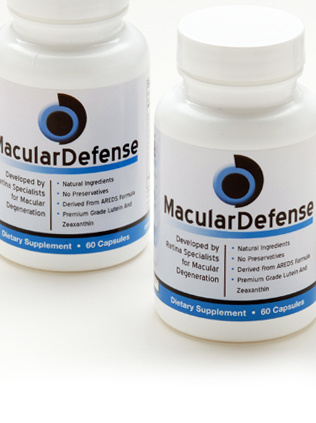
Ophthalmology glossary
Age Related Macular Degeneration
AREDS and AREDS 2
Lutein and Zeaxanthin
MacularDefense® product information

AMD and ARMD Acronyms for Age Related Macular Degeneration which is the leading cause of blindness in patients over 65.
AREDS 2001 Age-Related Eye Disease Study conducted by the National Eye Institute which concluded specific nutrients may slow the progression of AMD.
AREDS 2 Age-Related Eye Study conducted by the National Eye Institute which concluded in 2013 and refined the original AREDS formula.
Cataract Clouding of the lens that causes decreased vision.
Drusen Small yellow or white accumulations of extra cellular material that build up in eye.
FA Fluorescein Angiography is a diagnostic procedure in which a rapid sequence of photographs is taken to document the blood circulation of the retina.
Intravitreal Injection Injection of medication into the vitreous of the eye.
Lutein Antioxidant carotenoid found in the macula which helps keep the eyes safe from oxidative stress and the high-energy photons of blue light.
Macula Oval-shaped highly pigmented yellow spot near the center of the retina.
OCT Optical Coherence Tomography is a test used to diagnose Macular Degeneration.
Retina Light-sensitive tissue containing photoreceptor cells and lining the inner surface of the eye.
Vitreous Soft, jelly-like material that fills the space between the lens and the retina.
Zeaxanthin Antioxidant carotenoid found in the retina and acts as a filter and shield against the damaging near-to-UV blue light from the sun.

What is AMD?
Age-Related Macular Degeneration (AMD or ARMD) is the leading cause of vision loss among people over the age of 65. It is a process of wear and tear in the macula, which is the center part of the vision in the eye. Usually it affects both eyes with either gradual or abrupt loss of vision. It can affect your ability to read, drive and see fine details. Since side vision is rarely affected by macular degeneration, the disease typically does not lead to total blindness. It is also not caused by overusing your eyes. There are two types of macular degeneration - the dry type, which causes a gradual loss of vision, and the wet type, which causes a sudden loss of vision.
What are the symptoms with each type of macular degeneration?
With the dry type of macular degeneration, letters may look blurry since cells in portions of the center part of the vision in the macula have begun to die, leaving blind spots in your vision. Sometimes you can also see wavy lines. When the cells don't work well and degenerate, patients notice a gradual loss of vision.
With the wet type of macular degeneration, there may be dark spots in the center of the vision due to fluid underneath the macula. Straight lines may appear wavy because of fluid underneath the macula. With wet macular degeneration, there can be rapid and severe loss of vision, which occurs when abnormal blood vessels grow for unknown reasons under the retina. These abnormal blood vessels are fragile and leak fluid and blood, causing bulging of the macula that results in distortion.
What are the risk factors for getting macular degeneration?
The following increases your risk of getting AMD: (1) over 65 years old, (2) smoker, (3) family history of AMD, (4) vitamin deficient diet, (5) excessive sun exposure.
Is macular degeneration hereditary?
There is scientific evidence of a genetic component to AMD, but it is only one factor and a person can develop AMD without any family history of the disease.
Can you get macular degeneration in just one eye?
AMD affects both eyes, but the progression might not be equal. However, as the disease progresses, it will affect both eyes equally.
Does Dry AMD eventually lead to Wet AMD?
The progression of the disease is different in every person. Some people have Dry AMD for years and never develop Wet AMD. However, a person with Dry AMD is at increased risk for developing Wet AMD. Dry AMD patients should be vigilant in monitoring the progression of their disease. There are many promising treatments for wet AMD but early detection is essential.
Does macular degeneration have early, intermediate and advanced forms?
All wet AMD cases are considered advanced. However, dry AMD does have three stages:
1) Early Dry AMD: there are several small drusen or a few medium sized drusen. There is no noticeable change in vision.
2) Intermediate Dry AMD: there are many medium sized drusen over one or more large drusen. Some patients may need a brighter light to read and may have blurry vision in the center of their vision field.
3) Advanced Dry AMD: there are large drusen deposits and a breakdown of the light sensitive receptors and tissue surrounding the retina. There is a large blurry spot in the center of the vision field and may, eventually, lead to total vision loss in the center.
How can you diagnose macular degeneration?
The diagnosis of macular degeneration is made with a comprehensive ophthalmic examination, which may or may not include the use of photographic tests, including fluorescein angiogram and optical coherence tomography (OCT).
What is the treatment for macular degeneration?
For the dry type of macular degeneration, there is ongoing research being performed to determine how to prevent and/or slow the progression of the disease. The Age-Related Eye Disease Study (AREDS and AREDS 2) has shown promising results that dietary supplements may slow the progression of AMD.
Where can I find more information about AMD treatment?
Try these websites:
http://www.revophth.com/content/d/features/i/1211/c/22831/
http://www.nei.nih.gov/amd/
http://www.nei.nih.gov/areds2/
Besides lasers and injections, what are the other treatments for macular degeneration?
Currently, low vision aids or magnifiers can help compensate for vision loss in some cases. These aids can help with close work such as reading, cooking or sewing. They may enlarge letters and numbers and can help with daily tasks. Other aids that may be of help are talking books or calculators. The American Foundation for the Blind is a good source for these aids. Another good resource is the State Society for the Blind. You can get more information by calling:
The American Foundation for the Blind • 800.AFBLIND (232.5463)
The National Association for the Visually Handicapped • 212.889.3141
The Foundation Fighting Blindness • 800.683.5555
Can I slow the progression of AMD with diet?
Some studies indicate a diet that is rich in carotenoids, antioxidant vitamins (C and E) and omega-3 fatty acids may slow the progression of AMD.
Carotenoids are compounds that are in plants, which have not only been associated with protection against AMD, but in reducing the risk of certain cancers, heart disease, diabetes and a number of other medical conditions.
Will cataract surgery worsen macular degeneration?
Removing the cataract will let more light into the eye which may increase the vision of a patient suffering from AMD. Recent research has concluded that cataract surgery does not contribute to the progression of AMD. However, all surgery has risks that should be discussed with your doctor.
What is AREDS?
The Age-Related Eye Disease Study (AREDS) was a ten year study completed in 2001 and sponsored by the federal government's National Eye Institute. AREDS data concluded that people with a risk of developing AMD or were in the early to moderate stages of AMD lowered their risk of permanent vision loss when treated with Vitamin C, Vitamin E, Vitamin A and Zinc.
What is AREDS 2?
The Age-Related Eye Disease Study 2(AREDS 2) was a seven year study completed in 2013 and sponsored by the federal government's National Eye Institute. AREDS 2 reviewed the original AREDS formula and looked at adding lutein, zeaxanthin and omega-3 fatty acids.
- a. Lutein and zeaxanthin are in the same family of nutrients as beta-carotene. Beta –Carotene (Vitamin A) is in the original AREDS formula but has been associated with increased risk of lung cancer in smokers. The researchers found that substituting lutein and zeaxanthin for beta-carotene a safe and effective alternative to beta-carotene.
- b. The study found that omega-3 fatty acids had no effect on AMD progression.
What is the AREDS 2 formula?
The daily dose:
500 mg vitamin C
400 IU Vitamin E
10 mg Lutein
2 mg Zeaxanthin
80 mg Zinc Oxide
2 mg Copper Oxide
Does MacularDefense contain the vitamins and minerals similar to AREDS 2?
YES. MacularDefense® builds upon the AREDS formula by adding B Vitamins. Recent data from 2010 suggests a visual benefit from all of these nutrients.
What are Lutein and Zeaxanthin?
They are potent antioxidant carotenoids found in fruits and green leafy vegetables. They are the dominant pigments found in the macula, which can increase the macular pigment density.
Why use FloroGLO® brand Lutein?
FloraGLO® Lutein is patented. Its purification process is unique and innovative enough to have earned patent protection in the United States, Canada and other countries. Nutritional supplement companies worldwide recognize FloraGLO® Lutein as a quality ingredient that will maintain its stability – and potency – in tablets, capsules, softgels and beverages. FloraGLO® Lutein is used in more clinical trials than any other lutein.
Why use OPTISHARP™ brand Zeaxanthin?
OPTISHARP™ is the premium brand of Zeaxanthin, which is the most potent antioxidant carotenoid found in the retina and acts as a filter and shield against the damaging near-to-UV blue light from the sun. Zeaxanthin cannot be synthesized by humans and must be obtained from the diet. It is found mainly in colorful fruits and vegetables, such as corn, oranges, spinach and peppers.
Can I take my multi-vitamin with MacularDefense®?
Yes, we recommend a one-a-day multi-vitamin in addition to MacularDefense®.
Where is MacularDefense® manufactured?
MacularDefense® is manufactured at a facility located in the United States that is GMP certified and meets the strictest international criteria for hygiene and security.
I am a smoker. Can I take MacularDefense®?
You need to consult your physician to make sure you can take the Vitamin A that is in MacularDefense®.
I have trouble swallowing. Can I take MacularDefense®?
Yes. The capsules are small. The capsules can also, if necessary, be opened and mixed in any liquid.
How much does MacularDefense® cost?
MacularDefense costs $25 for a 30-day supply, or $70 for a 90-day supply.
How do I get MacularDefense®?
Order on our website and it will be shipped to your house at no additional cost. Or you can buy it at any of our metro-Detroit distributors listed on this website.
How long will it take to get MacularDefense®?
5–7 business days once your order is received.








 BACK TO TOP
BACK TO TOP


